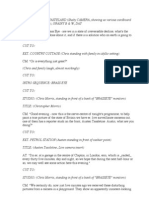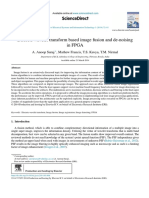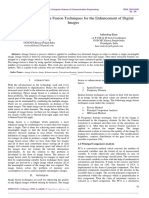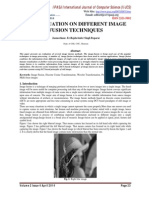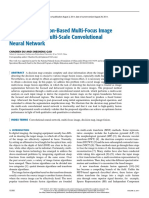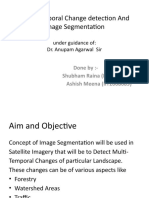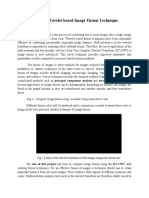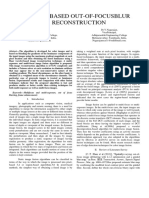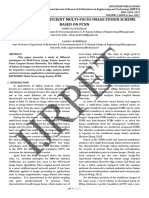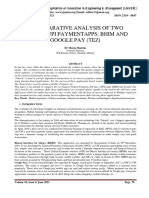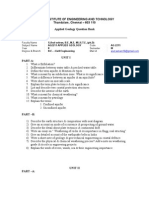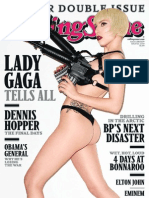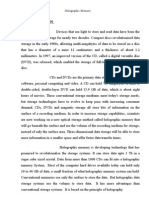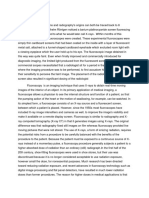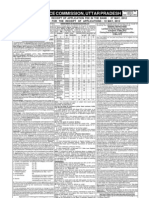Pixel - Based and Region - Based Image Fusion by A Ratio of Low - Pass Pyramid
Pixel - Based and Region - Based Image Fusion by A Ratio of Low - Pass Pyramid
Copyright:
Available Formats
Pixel - Based and Region - Based Image Fusion by A Ratio of Low - Pass Pyramid
Pixel - Based and Region - Based Image Fusion by A Ratio of Low - Pass Pyramid
Original Title
Copyright
Available Formats
Share this document
Did you find this document useful?
Is this content inappropriate?
Copyright:
Available Formats
Pixel - Based and Region - Based Image Fusion by A Ratio of Low - Pass Pyramid
Pixel - Based and Region - Based Image Fusion by A Ratio of Low - Pass Pyramid
Copyright:
Available Formats
International Journal of Application or Innovation in Engineering & Management (IJAIEM)
Web Site: www.ijaiem.org Email: editor@ijaiem.org
Volume 3, Issue 12, December 2014
ISSN 2319 - 4847
Pixel - based and region based image fusion by
a ratio of low - pass pyramid
1
A. Mallareddy, 2 B. Swetha, 3 K. Ravi Kiran
Research Scholar(JNTUH), Department of Computer Science & Engineering,
Professor &HOD(CSE) Sri Indu Institute of Engineering & Technology,
Sheriguda(V), Ibrahimpatnam(M), RR Dist 501510.
2
M.Tech (CS) , Department of Computer Science & Engineering,
Sri Indu Institute of Engineering & Technology, Sheriguda(V), Ibrahimpatnam(M), RR Dist 501510.
3
Assistant Professor, Department of Computer Science & Engineering,
Sri Indu Institute of Engineering & Technology, Sheriguda(V), Ibrahimpatnam(M), RR Dist 501510.
ABSTRACT
Multiscale makes great change are among the most pleasing to all techniques in the field of pixel-level image join by heating.
However, the join by heating operation of these methods often gets bad for images formed (from) from different sensor
modalities. In this paper, we put examples on view that for such images, results can be got better using a fiction story
undecimated wavelet transform (UWT)- based join by heating design, which cracks the image decomposition process into two
coming one after another coming through slowly operations using spectral making discovery of root amounts of the analysis
apparatus for making liquid clean. The true, in fact join by heating takes place after convolution with the first apparatus for
making liquid clean two. Its importantly smaller support size leads to the made-least of the not wanted spreading of coefficient
values around partly covering image singularities. This usually makes complex the point selection process and may lead to the
opening of remake errors in the forcefully joined together image. in addition, we will make clear to that the nonsubsampled
nature of the UWT lets the design of nonorthogonal apparatus for making liquid clean banks, which are more strong to
artifacts introduced during join by heating, in addition getting (making) better the got outcomes. The mix of these techniques
leads to a join by heating framework, which provides clear better chances over old and wise multiscale join by heating moves
near, independent of the close relation join by heating rule, and gets changed to other form not wanted side effects such as
ringing artifacts in the forcefully joined together remake.
1 INTRODUCTION
Within the last decades important forward development was achieved in the picturing sensor field. These movesforward led to the able to use of a sizeable amount of data, coming from multiple sensors. Frequently it is right to put
one thing into another such multisensor data into one made of different part or materials pictures of for sense given
purposes. In image-based applications this a great amount of mix techniques became generally known as image join by
heating and is in our time a making statement of undertaking research area. The process of image join by heating can
be did at bit of picture, point- or decision-level. image join by heating at pixel-level represents the mix of information at
the lowest level, since each bit of picture in the forcefully joined together image is determined by a group of bit of
picture in the starting point images. Generally, pixel-level techniques can be separated into spatial and make great
change lands ruled over techniques. Among the make great change lands ruled over expert ways of art and so on, the
most frequently used methods are based on multiscale makes great change where join by heating is did on a number of
different scales and adjustments, independently. The multiscale makes great change usually given work are pyramid
makes great change , the formed of separate parts wavelet transform (dwt 10) , , the Undecimated wavelet transform
(UWT), the Dual-Tree Complex wavelet transform (DTCWT) , the Curvelet make great change (CVT), the Contourlet
make great change (CT) and the Nonsubsampled Contourlet make great change (NSCT) . Please note that only
multiscale pixel-level image join by heating will be made house numbers in the direction of this work. In addition, all
input images are taken to be true to be adequately got into line and recorded, listed before to the join by heating process.
In multiscale pixel-level image join by heating, a make great change coefficient of an image is connected with a point if
its value is effected by the features bit of picture. In order to make simpler the discussion, we will have relation to a
given decomposition level j, adjustment band p and position m, n of a coefficient as its localization. A given point from
Volume 3, Issue 12, December 2014
Page 63
International Journal of Application or Innovation in Engineering & Management (IJAIEM)
Web Site: www.ijaiem.org Email: editor@ijaiem.org
Volume 3, Issue 12, December 2014
ISSN 2319 - 4847
one of the starting point images is only kept from change correctly in the forcefully joined together image if all
connected coefficients are given work to produce the forcefully joined together multiscale pictures of. However, in many
situations this is not useful from that time, given a localization, the coefficient yA (I) from image IA may be connected
to a point fA and the coefficient YB(I) from image IB may be connected to a point Forward Base. In this example,
selecting one coefficient instead of the other may outcome in the loss of an important chief point
Fig. 1. Schematic diagram of the proposed framework.
from one of the starting point images. For example, in the example of a make seem different person putting out of the
way behind a bush the person may come into view as only in the infrared image and the bush only in the able to be seen
image. If the bush has high textural what is in, this may outcome in greatly sized coefficient values at coincident
localizations in both decompositions of an infrared-visible image two. however, in order to keep as much as possible of
the information from the place, most coefficients being the property of to the person (infrared image) and the bush (able
to be seen image) would have to be got moved from one position to another to the forcefully joined together
decomposition. If there are many such coefficients at coincident localizations, a join by heating rule that selects just one
of the coefficients for each localization may present breaks in the forcefully joined together subband signals. These may
lead to remake errors such as ringing artifacts or important loss of information in the last forcefully joined together
image. It is important to note that the above said-about hard question is made-worse with the increase of the support of
the apparatus for making liquid clean used during the decomposition process. This results in a bad, not good spreading
of coefficient values over the one part of town of chief points, putting into use for first time added areas that put on
view coefficients in the source images with coincident localizations. In an earlier work, Petrovic and Xydeas dealt with
this hard question by employing image degrees of slope. In this paper, we make an offer a new UWT-based pixel-level
image fusion approach, which attempts to get round the coefficient spreading hard question by making into two the
image decomposition way into two coming one after another apparatus for making liquid clean operations using
spectral making discovery of root amounts of the analysis apparatus for making liquid clean. A schematic flow-chart of
the suggested image fusion framework is given in Fig. 1. The co-registered source images are first greatly changed to
the UWT lands ruled over by using a very short apparatus for making liquid clean two, formed (from) from the first
spectral factor of the overall analysis come through slowly bank. After the fusion of the high-pass coefficients, the
second apparatus for making liquid clean two, made up of all still in the same way spectral factors, is sent in name for
to the near to and forcefully joined together, detail images. This gives in the first decomposition level of the made an
offer fusion move near. Next, the process is recursively applied to the near to images until the desired decomposition
distance down is got to. After merging the near to images at the roughest scale the inverse make great change is sent in
name for to the made of different part or materials UWT pictures of, coming out in the last forcefully joined together
image. Word that one is going that this methodology is in comparison to conventional multiscale image fusion
approaches, where the detail image fusion is not did until the input image signals are fully decomposed using an
analysis come through slowly bank without spectral making discovery of root amounts. In addition, the gave effect to
apparatus for making liquid clean banks were especially designed for the use with the UWT and put on view useful
properties such as being strong to the ringing artifact hard question. In the direction of this work, we will make clear to
that our framework importantly gets better fusion results for a greatly sized group of input images.
2 Multiscale image fusion
In general, pixel-level techniques can be separated into spatial and make great change lands ruled over expert ways of
art and so on. As for spatial lands ruled over expert ways of art and so on, the fusion is did by putting together all input
images in a having an effect equal to the input or non-linear taste using weighted mean, authority to change or Total different in some way based Algorithms, make great change lands ruled over techniques map (make great change) each
source image into the make great change lands ruled over (e.g. wavelet domain), where the true, in fact fusion process
takes place. The last forcefully joined together image is got by taking the inverse make great change of the made of
Volume 3, Issue 12, December 2014
Page 64
International Journal of Application or Innovation in Engineering & Management (IJAIEM)
Web Site: www.ijaiem.org Email: editor@ijaiem.org
Volume 3, Issue 12, December 2014
ISSN 2319 - 4847
different part or materials pictures of. The main reason for doing behind moving to the make great change lands ruled
over is to work within a framework, where the images chief features are more clearly represented than in the spatial
lands ruled over. While many different makes great change have been put forward for image fusion purposes, most of
the make great change lands ruled over techniques use multiscale makes great change. This is was the reason for by the
fact that images have a tendency to present features in many different scales. In addition, the man-like seeing system
seems to put on view high similarities with the properties of multiscale makes great change. More through details,
strong facts supporting has existence that the complete man-like seeing field is covered by neurons that are having
selection to a limited range of adjustments and spatial number of times, and can discover nearby features like edges and
lines. This makes them very similar to the base group events of multiscale makes great change. The use of multiscale
image makes great change is not a nearby move near in image fusion requests. The first multiscale image fusion
approach was made an offer by Burt in 1985 and is based on the Laplacian pyramid in mix with a pixel-based greatest
selection rule. The use of the dwt in image fusion was first made an offer by Li et Al. In their putting into effect the
greatest point unlimited value within a window is selected as a right operation measure. In 2004 Pajares et Al. made
public a DWT-based image fusion tutorial including a completely work-room on coefficient merging expert ways of art
and so on. About the same time Petrovic and Xydeas presented another DWT-based move near which used a rate of
change image pictures of in mix with so-named rate of change apparatus for making liquid clean. The current fusion
was did on the rate of change images, pointing the writers to have relation to their something given as a fuse-thendecompose move near. Despite the good outcome of classical wavelet ways of doing, some limiting conditions get
changed to other form their good effect in certain places, positions. For example, wavelets get support from on a wordbook of roughly isotropic elements and their base purposes, uses are adjustment to events only on a small number of
directions, needing payment to the quality example tensor product making in two dimensions (2-D). This led to the
opening of several new multiscale makes great change in nearby years, that are able to get round these shortcomings
and make prisoner the intrinsic properties of natural images better than classical multiscale makes great change.
Among them, The DTCWT , and the NSCT , are in a wide ranging way used in image fusion applications (see , , ) .
More lately, Li et Al. guided an operation work-room on different multiscale makes great change for image fusion and
stated that the best results for medical, multifocus and multisensor image fusion can be achieved using the NSCT,
moved after by the DTCWT and the UWT.
3. Uwt-based fusion scheme with spectral factorization
As we have seen in the earlier part, an input image can be represented in the make great change lands ruled over by an
order of detail images at different scales and adjustments in company with a near to image at the roughest scale. for this
reason, the multiscale decomposition of an input image Ik can be represented as
Yk={yk1,yk2 .,ykj,xkj}
where xkj represents the near to image at the lowest scale J and ykj , j = 1, . . . , J represent the detail images at level J .
These are had among its parts of different adjustment bands ykj ={ ykj[. , 1], ykj[. , 2], ykj[.,P],},p= 1,..,P. For toilet we
will from now on use the guide order n= [m,n] to list of words in a book the place of the coefficients. In this way,
ykj[n,p] represents the detail coefficient of input image k , at place n, within decomposition level j and adjustment band
p. In order to make simpler the discussion, we assume, without loss of generality, that the forcefully joined together
image will be produced from two source images IA and IB which are taken to be true to be recorded, listed before to the
fusion process.
A. spectral making discovery of root amounts
Great amount of makes great change are at our get off one's hands to act image fusion works, among them the dwt, Cvt
and CT, as well as the UWT, Dtcwt and NSCT. A first order can be made based on the close relation more than is
needed and shift-variance of these makes great change. in view of the fact that the highly redundant UWT, DTCWT
and NSCT are invariant to shifts taking place in the input images, The dwt, CVT and CT represent shift variant makes
great change with no or limited more than is needed. As stated in different studies (e.g.,), more than is needed and
shift-invariance are desirable properties in image fusion applications since they let for a higher strength to quick
changes in coefficient values, in this way, reducing the amount of remake errors in the forcefully joined together image
was the reason for by these observations, we will put out as of no use the dwt, CVT and CT and chief place one and
only on redundant makes great change in our going on discussion. Another important point in multiscale bit of picture
level image fusion frameworks is the good quality of a right apparatus for making liquid clean bank Fig 2 attempts to
make clear by example or pictures the force of meeting blow of the length of the selected apparatus for making liquid
clean bank on the fusion operation. In this example the highpass divisions of two d step purposes, uses are forcefully
joined together using one stage of the ready to use Haar and apparatus on end of pipe db3 apparatus for making liquid
clean separately.
Volume 3, Issue 12, December 2014
Page 65
International Journal of Application or Innovation in Engineering & Management (IJAIEM)
Web Site: www.ijaiem.org Email: editor@ijaiem.org
Volume 3, Issue 12, December 2014
ISSN 2319 - 4847
Fig. 2. Coefcient spreading effect. (a) and (e) Input signals. (b) and (f) Haar ltered input signals.
(c) and (g) db3 ltered input signals. (d) Fusion of the Haar ltered signals. (h) Fusion of the db3 ltered signals.
The sent in name for fusion rule is a very simple select max rule as expressed in eq. The high way sub bands got by
putting to use the Haar apparatus for making liquid clean can be seen in Fig 2 b and f in view of the fact that the
outcome using the apparatus on end of pipe db3 apparatus for making liquid clean is pictured in Fig 2 c and g. It can
be observed that the db3 apparatus for making liquid clean needs five coefficients to represent the step change. Thus
although most energy is concentrated in the middle coefficient the still in the same way four coefficients be like to
fields, ranges where no change in the signal value occurred. When attempting to bit of wire that stops over-strong
current the two db3 made clean high way sub bands we are put face-to-face with a hard question namely to trading
group the two signals without not keeping information. This can be observed in Fig 2 h where not all not zero
coefficients from Fig 2 c and g could be made into company. On the other hand the Haar made clean signal has in it
only one not zero coefficient being like (in some way) exactly to the position of the signal transition. Thus as pictured
in Fig 2 d both not zero coefficients are got moved from one position to another to the forcefully joined together image
without any loss of information as an outcome of that it can be concluded that apparatus for making liquid clean with
greatly sized support size may outcome in a bad, not good spreading of coefficient values which if of chief features
placed very close to each other in both input images may lead to coefficients with coincident localizations in the make
great change lands ruled over. Since it is hard to get broken up such be covered in part twisting may be introduced
during the fusion process such as ringing artifacts or even loss of information. Although the place, position represented
in Fig 2 may seem at first somewhat not natural we will see in the next parts that multi sensor images and among them
especially medical image twos often put on view similar properties for this reason for these images the fusion operation
considerably degrades with an increase of the come through slowly size. We can therefore get changed to other form
the hard question of selecting a right redundant multiscale make great change to its power to make into one an
apparatus for making liquid clean bank with an enough small support size thus making seem unimportant the
coefficient spreading hard question. From this point of view the UWT appears to be a good-looking good quality since
needing payment to the quality example tensor product making in d the UWT offers directionality without increasing
the overall length of the gave effect to apparatus for making liquid clean bank a property not shared by the NSCT and
DTCWT As for the NSCT the increased apparatus for making liquid clean lengths are mainly needing payment to the
done again and again nature of the non sub sampled direction-guided apparatus for making liquid clean bank mixed in
trouble see for a complete discussion on the making of direction-guided come through slowly banks. In the example of
the DTCWT as stated in the increased apparatus for making liquid clean length is needing payment to the half sample
loss (waste) of time condition made over-great use of on the apparatus for making liquid clean banks complex which
results in longer apparatus for making liquid clean than in the true wavelet transform example. Supporters the remarks
stated so far we are gave in to strong desire to get to at the ending that the best fusion results for source images formed
(from) from different sensor modalities are got by simply putting to use the UWT in mix with the very short apparatus
on end of pipe. Haar apparatus for making liquid clean bank Indeed surprisingly good results are achieved using this
simple fusion secret design for infrared visible and medical image fusion. However the Haar apparatus for making
liquid clean bank presents some well certain things short of, without like the opening of getting in the way artifacts
when remaking an image after doing something of its wavelet coefficients which might become less in value the fusion
operation in certain situations. This is mainly needing payment to the feeble amount of regularity put on view by the
Haar wavelet roughly talking the regularity of a wavelet or scaling group event t and t separately gives the story of to
the number of continuous comes from that a wavelet has in example of the Haar wavelet the low way analysis apparatus
for making liquid clean H (z) has only one zero at z = -1 leading to the well within one's knowledge non smooth Haar
scaling purpose, use In order to make smoother scaling group events more zeros have to be introduced at Z = -1 as
necessary leading to apparatus for making liquid clean with longer support. Based on these observations we get to at
Volume 3, Issue 12, December 2014
Page 66
International Journal of Application or Innovation in Engineering & Management (IJAIEM)
Web Site: www.ijaiem.org Email: editor@ijaiem.org
Volume 3, Issue 12, December 2014
ISSN 2319 - 4847
the supporters question. How can we group together the better chances of apparatus for making liquid clean with small
support size with the ones of apparatus for making liquid clean banks putting on view a high degree of regularity in the
makes sense clearer of image fusion. In common multi scale fusion moves near this question for which decision is hard
usually results in a trade off between short length apparatus for making liquid clean and apparatus for making liquid
clean with better regularity and number of times lands ruled over behavior usually with a small tendency in a certain
direction in the direction of come through slowly banks with short support sizes. In this paper we make an offer a new
UWT based fusion move near that separates the coming through slowly process into two coming one after another
coming through slowly operations and acts the true, in fact fusion after convolving the input signal with the first
apparatus for making liquid clean two putting on view an importantly smaller support size than the first form come
through slowly. The made an offer way is based on the fact that the low way analysis apparatus for making liquid clean
H (z) and the being like (in some way) high way analysis apparatus for making liquid clean G ( z) can always be
expressed in the form
H (z) = (1 + z-1) p (z)
G (z) = (1 z-1 ) Q (z)
(1)
(2)
Fig. 3. Implementation of the UWT-based fusion scheme with spectral factorization for two decomposition levels in 1D.
by spectral making discovery of root amounts in the Z make great change lands ruled over. Thus in our framework the
input images are first decomposed by putting to use a Haar apparatus for making liquid clean two represented by the
first spectral factors (1+ Z-1 and 1 - Z-1 ), separately. The coming out horizontal upright and lines on an angle detail
images can after be forcefully joined together according to a not based on rules fusion rule nearest the apparatus for
making liquid clean two represented by the second spectral factor ( P(z) and Q(z) ) in eq 1 is sent in name for to the
near to and forcefully joined together detail images giving in the first decomposition level of the made an offer fusion
design. For each coming after level the analysis apparatus for making liquid clean are upsampled according to the trous
Algorithm leading to the supporters made general analysis come through slowly bank and the named before way is
recursively applied to the near to images until the desired number of decomposition levels is got to after merging the
low go through near to images the last forcefully joined together image is got by putting to use the inverse make great
change using the being like (in some way) putting-together apparatus for making liquid clean bank without spectral 1
making discovery of root amounts. The putting into effect of the made an offer Algorithm for two 1-D signals xA and
xB and two decomposition levels is represented in Fig where F is a sign of the fusion of the high way coefficients. It is
important to weight, special force that spectral making discovery of root amounts is not sent in name for to the low way
apparatus for making liquid clean H (z) since it is taken to be true that all chief features of the input signals are put in
words in the high number of times coefficients Although this thing taken as certain remains also true for images when
using separable apparatus for making liquid clean the horizontal and upright detail bands are got by putting to use both
low pass and high way apparatus for making liquid clean to the columns and lines of the input images. Thus it is
necessary to put to use spectral making discovery of root amounts also to the low way narrow way. Only if of the low
narrow way coming one after another attention to of H (z) to the columns and lines of the input image spectral making
Volume 3, Issue 12, December 2014
Page 67
International Journal of Application or Innovation in Engineering & Management (IJAIEM)
Web Site: www.ijaiem.org Email: editor@ijaiem.org
Volume 3, Issue 12, December 2014
ISSN 2319 - 4847
discovery of root amounts will not be given work. The putting into effect of the first stage of our image fusion
framework is represented in Fig 4. The strange newness of the made an offer fusion framework lies in its power to
group together the properties of apparatus for making liquid clean with short support size with apparatus for making
liquid clean with greatly sized support size and therefore higher regularity. In more detail needing payment to the very
solid (substance) support of the used ( 1 Z -2 j-1 ) factors the bad, not good spreading of coefficient values in the one
part of town of chief features during the convolution process is largely made lower, less this lets for a more safe, good
point selection and gets changed to other form both the opening of twisting and the loss of comparison information
during the fusion process conditions commonly observed in old and wise multi scale fusion frameworks. The coming
after coming through slowly with the second spectral factor accounts for the freedom of implementing an not based on
rules apparatus for making liquid clean bank making free from doubt the errorless remake condition for this reason
putting together the better chances of a very short apparatus for making liquid clean with the benefits of apparatus for
making liquid clean with higher orders. In other words we keep from the opening of getting in the way artifacts during
remake as well as the coefficient spreading hard question. Please note that the spectral making discovery of root
amounts design as presented in this subsection cannot be straightforwardly adjusted to the NSCT and the DTCWT.
This is mainly needing payment to the apparatus for making liquid clean design restrictions made over-great use of by
these makes great change putting a stop to the purposeful use of such a making discovery of root amounts design. As
we are going to play or amusement later the presented move near is particularly well was good, right for the fusion of
infrared able to be seen and medical images which have a tendency to put on view a high degree of information at
coincident localizations. For these image groups the presented framework outdoes old and wise fusion frameworks
based on the DTCWT and NSCT.
4 CONCLUSION
A fiction story UWT-based pixel-level image join by heating approach is presented in this paper. It successfully gets
better join by heating results for images giving signs of features at near placed or coincident bit of picture places
conditions commonly but not only discovered in multi sensor picturing. Our way spectrally makes a division the
observations apparatus for making liquid clean two into two factors which are then separately sent in name for to the
input image two, making into two the image decomposition way into two coming one after another apparatus for
making liquid clean operations. The true, in fact join by heating step takes place after convolution with the first
apparatus for making liquid clean two. It is equal, as far as the coefficient put out on top is had a part in, to an
apparatus for making liquid clean with importantly smaller support size than the first form come through slowly two.
In this way, the effect of the coefficient spreading hard question, which takes care of to considerably make complex the
point selection process, is successfully made lower, less. This leads to a better keeping from destruction of features
which are placed close to each other in the input images. In addition, this answer lets go of room for further
improvements by taken g advantage of the nonsubsampled nature of the UWT, which permits the design of nonorthogonal apparatus for making liquid clean banks where both putting-together apparatus for making liquid clean put
on view only positive coefficients. Such apparatus for making liquid clean make ready a remade, forcefully joined
together image less open to attack to ringing artifacts. The got testing results have been got broken up (into simpler
parts) in terms of the three end metrics QAB/F, Mi and QP. They showed that for multisensor images, such as infraredvisible and medical image twos, the made an offer spectral making discovery of root amounts framework importantly
outdoes join by heating designs based on state-of-the-art makes great change such as the DTCWT and NSCT,
independent of the close relation join by heating rule. In addition, the perceptual being higher, greater of the made an
offer framework was suggested by simple seeing check-out of a forcefully joined together infrared-visible as well as a
forcefully joined together medical image two.
REFERENCES
[1] Z. Zhang and R. S. Blum, A categorization of multiscaledecomposition based image fusion schemes with a
performance study for a digital camera application, Proc. IEEE, vol. 87, no. 8, pp. 1315 1326, Aug. 1999.
[2] N. Mitianoudis and T. Stathaki, Pixel-based and region-based image fusion schemes using ICA bases, Inf.
Fusion, vol. 8, no. 2, pp. 131 142, 2007.
[3] P. J. Burt, The pyramid as a structure for efficient computation, in Multiresolution Image Processing and
Analysis. Berlin, Germany: Springer-Verlag, 1984, pp. 635.
[4] A. Toet, Image fusion by a ratio of low-pass pyramid, Pattern Recognit. Lett., vol. 9, no. 4, pp. 245253, 1989.
[5] Z. Liu, K. Tsukada, K. Hanasaki, Y. K. Ho, and Y. P. Dai, Image fusion by using steerable pyramid, Pattern
Recognit. Lett., vol. 22, no. 9, pp. 929939, 2001.
[6] G. Piella, Adaptive wavelets and their applications to image fusion and compression, Ph.D. dissertation, Dept.
Comput. Sci., Univ. Amsterdam, Amsterdam, The Netherlands, 2003.
[7] Z. Zhang and R. S. Blum, Region-based image fusion scheme for concealed weapon detection, in Proc. 31st
Annu. Conf. Inf. Sci. Syst., Apr. 1997, pp. 168173.
Volume 3, Issue 12, December 2014
Page 68
International Journal of Application or Innovation in Engineering & Management (IJAIEM)
Web Site: www.ijaiem.org Email: editor@ijaiem.org
Volume 3, Issue 12, December 2014
ISSN 2319 - 4847
[8] H. Li, B. S. Manjunath, and S. K. Mitra, Multisensor image fusion using the wavelet transform, Graph. Models
Image Process., vol. 57, no. 3, pp. 235245, 1995.
[9] V. S. Petrovic and C. S. Xydeas, Gradient-based multiresolution image fusion, IEEE Trans. Image Process., vol.
13, no. 2, pp. 228237, Feb. 2004.
[10] G. Pajares and J. M. de la Cruz, A wavelet-based image fusion tutorial, Pattern Recognit., vol. 37, no. 9, pp.
18551872, 2004.
Volume 3, Issue 12, December 2014
Page 69
You might also like
- Brass Eye TranscriptDocument18 pagesBrass Eye TranscriptDavid Swan100% (1)
- Semi-Detailed Lesson Plan in Arts 10Document5 pagesSemi-Detailed Lesson Plan in Arts 10joy89% (9)
- A Novel Approach of Image Fusion MRI and CT Image Using Wavelet FamilyDocument4 pagesA Novel Approach of Image Fusion MRI and CT Image Using Wavelet FamilyInternational Journal of Application or Innovation in Engineering & ManagementNo ratings yet
- Performance Comparison of Different Multi-Resolution Transforms For Image FusionDocument6 pagesPerformance Comparison of Different Multi-Resolution Transforms For Image Fusionsurendiran123No ratings yet
- Image Fusion Algorithm Based On Biorthogonal WaveletDocument7 pagesImage Fusion Algorithm Based On Biorthogonal WaveletEmon KhanNo ratings yet
- Different Image Fusion Techniques - A Critical ReviewDocument4 pagesDifferent Image Fusion Techniques - A Critical ReviewIJMERNo ratings yet
- Discrete Wavelet Transform Based Image Fusion and De-Noising in FpgaDocument10 pagesDiscrete Wavelet Transform Based Image Fusion and De-Noising in FpgaRudresh RakeshNo ratings yet
- Image Fusion Algorithm Based On Biorthogonal Wavelet: Vol. 1 Issue 2 January 2011Document6 pagesImage Fusion Algorithm Based On Biorthogonal Wavelet: Vol. 1 Issue 2 January 2011admin2146No ratings yet
- Different Image Fusion Techniques - A Critical Review: Deepak Kumar Sahu, M.P.ParsaiDocument4 pagesDifferent Image Fusion Techniques - A Critical Review: Deepak Kumar Sahu, M.P.ParsaiCatalina GireadaNo ratings yet
- Implementation of Medical Image Fusion Using DWT Process On FPGADocument4 pagesImplementation of Medical Image Fusion Using DWT Process On FPGAATSNo ratings yet
- Performance Evaluation of Integrated Dhe, Pca & Max-Dct Based Digital Image FusionDocument8 pagesPerformance Evaluation of Integrated Dhe, Pca & Max-Dct Based Digital Image FusionInternational Journal of Application or Innovation in Engineering & ManagementNo ratings yet
- Analysis of Fusion Techniques With Application To Biomedical Images: A ReviewDocument9 pagesAnalysis of Fusion Techniques With Application To Biomedical Images: A Reviewpraveenkumar smNo ratings yet
- Directional Light MapsDocument9 pagesDirectional Light MapsAndrei BadilaNo ratings yet
- Image FusionDocument44 pagesImage Fusionvinay999100% (9)
- Image Fusion Algorithm Based On Biorthogonal Wavelet: Vol. 1 Issue 2 July 2011Document6 pagesImage Fusion Algorithm Based On Biorthogonal Wavelet: Vol. 1 Issue 2 July 2011Vasudeva AcharyaNo ratings yet
- Image Fusion PresentationDocument33 pagesImage Fusion PresentationManthan Bhatt100% (1)
- Thesis On Image Fusion Using Wavelet TransformDocument8 pagesThesis On Image Fusion Using Wavelet Transformcgvmxrief100% (2)
- Tele ImmersionDocument20 pagesTele Immersionapi-3827000100% (8)
- A Novel Statistical Fusion Rule For Image Fusion and Its Comparison in Non Subsampled Contourlet Transform Domain and Wavelet DomainDocument19 pagesA Novel Statistical Fusion Rule For Image Fusion and Its Comparison in Non Subsampled Contourlet Transform Domain and Wavelet DomainIJMAJournalNo ratings yet
- Watershed Segmentation Based On Distance TransformDocument6 pagesWatershed Segmentation Based On Distance Transformrishi guptaNo ratings yet
- Study of Various Image Fusion Techniques For The Enhancement of Digital ImagesDocument4 pagesStudy of Various Image Fusion Techniques For The Enhancement of Digital ImagesRahul SharmaNo ratings yet
- Image Fusion: International Journal of Advanced Research in Computer Science and Software EngineeringDocument4 pagesImage Fusion: International Journal of Advanced Research in Computer Science and Software EngineeringIdris Khan PathanNo ratings yet
- UUSCI-2008-009A Directional Occlusion Shading Model For Interactive Direct Volume RenderingDocument10 pagesUUSCI-2008-009A Directional Occlusion Shading Model For Interactive Direct Volume Renderingtituandreescu6810No ratings yet
- InTech-High Speed Architecure Based On Fpga For A Stereo Vision AlgorithmDocument18 pagesInTech-High Speed Architecure Based On Fpga For A Stereo Vision AlgorithmdvtruongsonNo ratings yet
- Eo Learn 2Document18 pagesEo Learn 2Trung HoàngNo ratings yet
- V.karthikeyan Published Article A..aDocument4 pagesV.karthikeyan Published Article A..akarthikeyan.vNo ratings yet
- Adaptive Transcoders For Video & Image Sequence Using Wavelet TransformDocument7 pagesAdaptive Transcoders For Video & Image Sequence Using Wavelet TransformIOSRJEN : hard copy, certificates, Call for Papers 2013, publishing of journalNo ratings yet
- True ImpostorsDocument7 pagesTrue ImpostorsStanford AdderleyNo ratings yet
- Kwan2006 Article ACompleteImageCompressionSchemDocument15 pagesKwan2006 Article ACompleteImageCompressionSchemrube nobeNo ratings yet
- VLSI-Assisted Nonrigid Registration Using Modified Demons AlgorithmDocument9 pagesVLSI-Assisted Nonrigid Registration Using Modified Demons AlgorithmAnonymous ZWEHxV57xNo ratings yet
- 2002 WaldBookFusion Cha8 QualDocument22 pages2002 WaldBookFusion Cha8 QualEdwin Hernán HurtadoNo ratings yet
- Comparative Study of Image Fusion Methods: Nikita D.Rane Prof. Bhagwat Kakde Prof. Dr. Manish JainDocument7 pagesComparative Study of Image Fusion Methods: Nikita D.Rane Prof. Bhagwat Kakde Prof. Dr. Manish JainRahul SharmaNo ratings yet
- Image Contrast Enhancement Using Combination of DWT & SWT With CLAHEDocument4 pagesImage Contrast Enhancement Using Combination of DWT & SWT With CLAHEIJRASETPublicationsNo ratings yet
- Contourlet TransformDocument16 pagesContourlet TransformSiddharth PurohitNo ratings yet
- Iijcs 2014 04 05 008Document6 pagesIijcs 2014 04 05 008International Journal of Application or Innovation in Engineering & ManagementNo ratings yet
- Survey On Change Detection Techniques For Multitemporal Aerial Video SequencesDocument11 pagesSurvey On Change Detection Techniques For Multitemporal Aerial Video SequencesIJRASETPublicationsNo ratings yet
- Image Segmentation-Based Multi-Focus Image Fusion Through Multi-Scale Convolutional Neural NetworkDocument12 pagesImage Segmentation-Based Multi-Focus Image Fusion Through Multi-Scale Convolutional Neural NetworkWafa BenzaouiNo ratings yet
- Multi-Temporal Change Detection and Image Segmentation: Under Guidance Of: Dr. Anupam Agarwal SirDocument19 pagesMulti-Temporal Change Detection and Image Segmentation: Under Guidance Of: Dr. Anupam Agarwal SirAshish MeenaNo ratings yet
- Image Fusion Using Manual SegmentationDocument4 pagesImage Fusion Using Manual SegmentationInternational Journal of Application or Innovation in Engineering & ManagementNo ratings yet
- Development of An Algorithm That Allows Improving Disparity Maps in Environments Contaminated With Suspended ParticlesDocument7 pagesDevelopment of An Algorithm That Allows Improving Disparity Maps in Environments Contaminated With Suspended ParticlesDaniel Fernando Quintero BernalNo ratings yet
- Interactive Deformation and Visualization of Level Set Surfaces Using Graphics HardwareDocument18 pagesInteractive Deformation and Visualization of Level Set Surfaces Using Graphics Hardwaremilito411No ratings yet
- Contour Detection and Hierarchical Image SegmentationDocument19 pagesContour Detection and Hierarchical Image SegmentationQuynhtrang NguyenNo ratings yet
- Comparative Study of Frequency Vs Spacial Domain For Multi Sensor Image FusionDocument8 pagesComparative Study of Frequency Vs Spacial Domain For Multi Sensor Image Fusionpraveenkumar smNo ratings yet
- Verbal Non VerbalDocument6 pagesVerbal Non VerbalRashmi GangatkarNo ratings yet
- Project AbstractDocument2 pagesProject AbstractPraneeth BobbaNo ratings yet
- Survey On Different Image Fusion Techniques: Miss. Suvarna A. Wakure, Mr. S.R. TodmalDocument7 pagesSurvey On Different Image Fusion Techniques: Miss. Suvarna A. Wakure, Mr. S.R. TodmalInternational Organization of Scientific Research (IOSR)No ratings yet
- Patch-Based Out-Of-Focusblur Reconstruction: Abstract-The Algorithm Is Developed For Color Images and IsDocument6 pagesPatch-Based Out-Of-Focusblur Reconstruction: Abstract-The Algorithm Is Developed For Color Images and IsfyazgNo ratings yet
- A Review On An Efficient Multi-Focus Image Fusion Scheme Based On PCNNDocument3 pagesA Review On An Efficient Multi-Focus Image Fusion Scheme Based On PCNNJournalNX - a Multidisciplinary Peer Reviewed JournalNo ratings yet
- Multi-Source Image Registration Based On Log-Polar Coordinates and Extension Phase Correlation PDFDocument7 pagesMulti-Source Image Registration Based On Log-Polar Coordinates and Extension Phase Correlation PDFivy_publisherNo ratings yet
- Underwater Image Restoration Using Fusion and Wavelet Transform StrategyDocument8 pagesUnderwater Image Restoration Using Fusion and Wavelet Transform StrategyMega DigitalNo ratings yet
- Image Fusion Based On Wavelet and Curvelet TransformDocument5 pagesImage Fusion Based On Wavelet and Curvelet TransformInternational Organization of Scientific Research (IOSR)No ratings yet
- Technology integrationDocument11 pagesTechnology integrationp.maheswariopenventioNo ratings yet
- Laplace DerivatifDocument6 pagesLaplace DerivatifMuhammad IqbalNo ratings yet
- Iaetsd Image Fusion of Brain Images Using Discrete Wavelet TransformDocument4 pagesIaetsd Image Fusion of Brain Images Using Discrete Wavelet TransformiaetsdiaetsdNo ratings yet
- Tele ImmersionDocument20 pagesTele ImmersionOluwatoyosilorun AlukoNo ratings yet
- Novel Image Fusion Technique Based On DWT & MSVDDocument6 pagesNovel Image Fusion Technique Based On DWT & MSVDEditor IJRITCCNo ratings yet
- U-Net: Convolutional Networks For Biomedical Image SegmentationDocument8 pagesU-Net: Convolutional Networks For Biomedical Image SegmentationUsman SaeedNo ratings yet
- V.kartHIKEYAN Published Article3Document5 pagesV.kartHIKEYAN Published Article3karthikeyan.vNo ratings yet
- Optical Flow: Exploring Dynamic Visual Patterns in Computer VisionFrom EverandOptical Flow: Exploring Dynamic Visual Patterns in Computer VisionNo ratings yet
- Motion Estimation: Advancements and Applications in Computer VisionFrom EverandMotion Estimation: Advancements and Applications in Computer VisionNo ratings yet
- Multi View Three Dimensional Reconstruction: Advanced Techniques for Spatial Perception in Computer VisionFrom EverandMulti View Three Dimensional Reconstruction: Advanced Techniques for Spatial Perception in Computer VisionNo ratings yet
- Document Mosaicing: Unlocking Visual Insights through Document MosaicingFrom EverandDocument Mosaicing: Unlocking Visual Insights through Document MosaicingNo ratings yet
- Detection of Malicious Web Contents Using Machine and Deep Learning ApproachesDocument6 pagesDetection of Malicious Web Contents Using Machine and Deep Learning ApproachesInternational Journal of Application or Innovation in Engineering & ManagementNo ratings yet
- An Importance and Advancement of QSAR Parameters in Modern Drug Design: A ReviewDocument9 pagesAn Importance and Advancement of QSAR Parameters in Modern Drug Design: A ReviewInternational Journal of Application or Innovation in Engineering & ManagementNo ratings yet
- The Mexican Innovation System: A System's Dynamics PerspectiveDocument12 pagesThe Mexican Innovation System: A System's Dynamics PerspectiveInternational Journal of Application or Innovation in Engineering & ManagementNo ratings yet
- Analysis of Product Reliability Using Failure Mode Effect Critical Analysis (FMECA) - Case StudyDocument6 pagesAnalysis of Product Reliability Using Failure Mode Effect Critical Analysis (FMECA) - Case StudyInternational Journal of Application or Innovation in Engineering & ManagementNo ratings yet
- Study of Customer Experience and Uses of Uber Cab Services in MumbaiDocument12 pagesStudy of Customer Experience and Uses of Uber Cab Services in MumbaiInternational Journal of Application or Innovation in Engineering & ManagementNo ratings yet
- THE TOPOLOGICAL INDICES AND PHYSICAL PROPERTIES OF n-HEPTANE ISOMERSDocument7 pagesTHE TOPOLOGICAL INDICES AND PHYSICAL PROPERTIES OF n-HEPTANE ISOMERSInternational Journal of Application or Innovation in Engineering & ManagementNo ratings yet
- Study of Customer Experience and Uses of Uber Cab Services in MumbaiDocument12 pagesStudy of Customer Experience and Uses of Uber Cab Services in MumbaiInternational Journal of Application or Innovation in Engineering & ManagementNo ratings yet
- The Impact of Effective Communication To Enhance Management SkillsDocument6 pagesThe Impact of Effective Communication To Enhance Management SkillsInternational Journal of Application or Innovation in Engineering & ManagementNo ratings yet
- Design and Detection of Fruits and Vegetable Spoiled Detetction SystemDocument8 pagesDesign and Detection of Fruits and Vegetable Spoiled Detetction SystemInternational Journal of Application or Innovation in Engineering & ManagementNo ratings yet
- Staycation As A Marketing Tool For Survival Post Covid-19 in Five Star Hotels in Pune CityDocument10 pagesStaycation As A Marketing Tool For Survival Post Covid-19 in Five Star Hotels in Pune CityInternational Journal of Application or Innovation in Engineering & ManagementNo ratings yet
- Soil Stabilization of Road by Using Spent WashDocument7 pagesSoil Stabilization of Road by Using Spent WashInternational Journal of Application or Innovation in Engineering & ManagementNo ratings yet
- A Comparative Analysis of Two Biggest Upi Paymentapps: Bhim and Google Pay (Tez)Document10 pagesA Comparative Analysis of Two Biggest Upi Paymentapps: Bhim and Google Pay (Tez)International Journal of Application or Innovation in Engineering & ManagementNo ratings yet
- Ijaiem 2021 01 28 6Document9 pagesIjaiem 2021 01 28 6International Journal of Application or Innovation in Engineering & ManagementNo ratings yet
- An Importance and Advancement of QSAR Parameters in Modern Drug Design: A ReviewDocument9 pagesAn Importance and Advancement of QSAR Parameters in Modern Drug Design: A ReviewInternational Journal of Application or Innovation in Engineering & ManagementNo ratings yet
- Performance of Short Transmission Line Using Mathematical MethodDocument8 pagesPerformance of Short Transmission Line Using Mathematical MethodInternational Journal of Application or Innovation in Engineering & ManagementNo ratings yet
- Anchoring of Inflation Expectations and Monetary Policy Transparency in IndiaDocument9 pagesAnchoring of Inflation Expectations and Monetary Policy Transparency in IndiaInternational Journal of Application or Innovation in Engineering & ManagementNo ratings yet
- A Deep Learning Based Assistant For The Visually ImpairedDocument11 pagesA Deep Learning Based Assistant For The Visually ImpairedInternational Journal of Application or Innovation in Engineering & ManagementNo ratings yet
- The Effect of Work Involvement and Work Stress On Employee Performance: A Case Study of Forged Wheel Plant, IndiaDocument5 pagesThe Effect of Work Involvement and Work Stress On Employee Performance: A Case Study of Forged Wheel Plant, IndiaInternational Journal of Application or Innovation in Engineering & ManagementNo ratings yet
- Design and Manufacturing of 6V 120ah Battery Container Mould For Train Lighting ApplicationDocument13 pagesDesign and Manufacturing of 6V 120ah Battery Container Mould For Train Lighting ApplicationInternational Journal of Application or Innovation in Engineering & ManagementNo ratings yet
- Swot Analysis of Backwater Tourism With Special Reference To Alappuzha DistrictDocument5 pagesSwot Analysis of Backwater Tourism With Special Reference To Alappuzha DistrictInternational Journal of Application or Innovation in Engineering & ManagementNo ratings yet
- Impact of Covid-19 On Employment Opportunities For Fresh Graduates in Hospitality &tourism IndustryDocument8 pagesImpact of Covid-19 On Employment Opportunities For Fresh Graduates in Hospitality &tourism IndustryInternational Journal of Application or Innovation in Engineering & ManagementNo ratings yet
- Analysis of RCC Beam Using GFRP Wrapped With Cellular StirrupsDocument11 pagesAnalysis of RCC Beam Using GFRP Wrapped With Cellular StirrupsInternational Journal of Application or Innovation in Engineering & ManagementNo ratings yet
- Application of Mersey Silt As Fine Aggregate in ConcreteDocument9 pagesApplication of Mersey Silt As Fine Aggregate in ConcreteInternational Journal of Application or Innovation in Engineering & ManagementNo ratings yet
- Marco Economic Sustainability in India: Partisan Theory ApproachDocument7 pagesMarco Economic Sustainability in India: Partisan Theory ApproachInternational Journal of Application or Innovation in Engineering & ManagementNo ratings yet
- Mini Tesla Coil 100kv RevisedDocument9 pagesMini Tesla Coil 100kv RevisedmadmhackzNo ratings yet
- Balaji Institute of Engineering and Tchnology Thandalam, Chennai - 603 110 Applied Geology Question BankDocument5 pagesBalaji Institute of Engineering and Tchnology Thandalam, Chennai - 603 110 Applied Geology Question BankJackie ArulNo ratings yet
- Marie Claire USA October 2017Document225 pagesMarie Claire USA October 2017Viktoria HosszuNo ratings yet
- Properties of X-RayDocument7 pagesProperties of X-Raydattatray kulkarniNo ratings yet
- ATN Catalog 2013Document40 pagesATN Catalog 2013Son NguyenNo ratings yet
- The 9 - 11 Photos We Will Never ForgetDocument1 pageThe 9 - 11 Photos We Will Never ForgetRamonita GarciaNo ratings yet
- Project Report On Oppo MobilesDocument52 pagesProject Report On Oppo MobilesVarun Jain83% (6)
- Pes WesDocument12 pagesPes WesjotapintorNo ratings yet
- NIOS Class 12 Mass Communication CH 31 PhotojournalismDocument3 pagesNIOS Class 12 Mass Communication CH 31 PhotojournalismRizwan QamarNo ratings yet
- How To Inspect A Gearbox PDFDocument5 pagesHow To Inspect A Gearbox PDFsurawutwijarn100% (2)
- Excell CSC Gov PH ELIGSPECIAL Elig BHW HTMLDocument7 pagesExcell CSC Gov PH ELIGSPECIAL Elig BHW HTMLRoySantosMoralesNo ratings yet
- Take Home Package GR 8 SS Geography T3Document6 pagesTake Home Package GR 8 SS Geography T3laytemerle64No ratings yet
- Piedra Que Rueda y Rueda - 2010!07!22Document127 pagesPiedra Que Rueda y Rueda - 2010!07!22KGdavid100% (2)
- Photec Technical Process GuideDocument74 pagesPhotec Technical Process Guidezest321No ratings yet
- 50 Shades of Grey ReviewedDocument65 pages50 Shades of Grey Revieweddeano66100% (2)
- Cmeias 128Document105 pagesCmeias 128hacguest8485No ratings yet
- Call 38001 38909Document1 pageCall 38001 38909Naren DranNo ratings yet
- Rules of IDWC-21 CompetitionDocument1 pageRules of IDWC-21 CompetitionNityashree UttarwarNo ratings yet
- Digitizing ImagesDocument34 pagesDigitizing ImagesIzani ZainalNo ratings yet
- 最新2012广交会纺织服装类采购商名录Document936 pages最新2012广交会纺织服装类采购商名录dsndkNo ratings yet
- Holographic MemoryDocument18 pagesHolographic MemoryMukul Narayan50% (2)
- History of FluorosDocument2 pagesHistory of FluorosEvi DianNo ratings yet
- Six SketchesDocument38 pagesSix SketchesMihalache Roxana100% (3)
- Uppsc AdvtDocument3 pagesUppsc AdvtMukund MishraNo ratings yet
- Samantha-Jo Roth ResumeDocument2 pagesSamantha-Jo Roth ResumeSJ RothNo ratings yet
- Word 2013 ManualDocument15 pagesWord 2013 ManualLuisBritoNo ratings yet
- Legacy of Ansel Adams and Minor WhiteDocument7 pagesLegacy of Ansel Adams and Minor WhiteMaria DiamantopoulouNo ratings yet
- World Atlas of UFOs - John SpencerDocument200 pagesWorld Atlas of UFOs - John SpencerAravinth Kumar100% (3)
